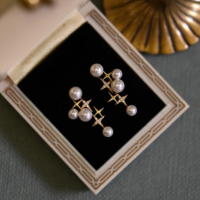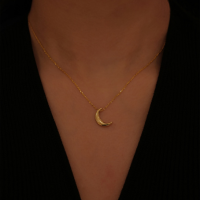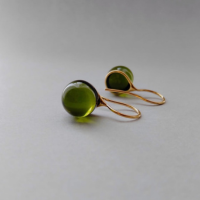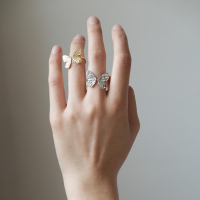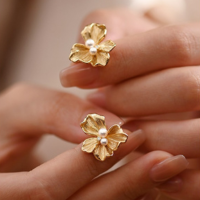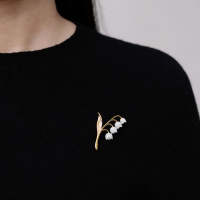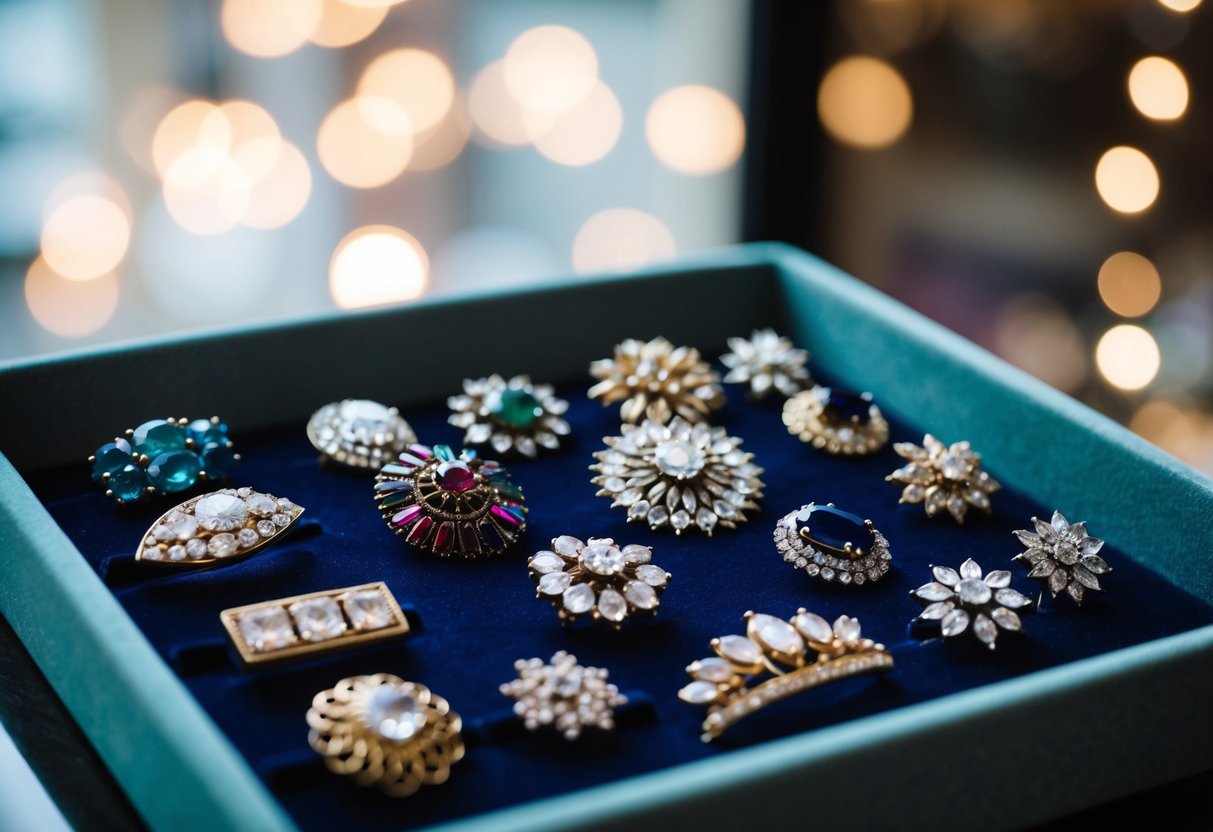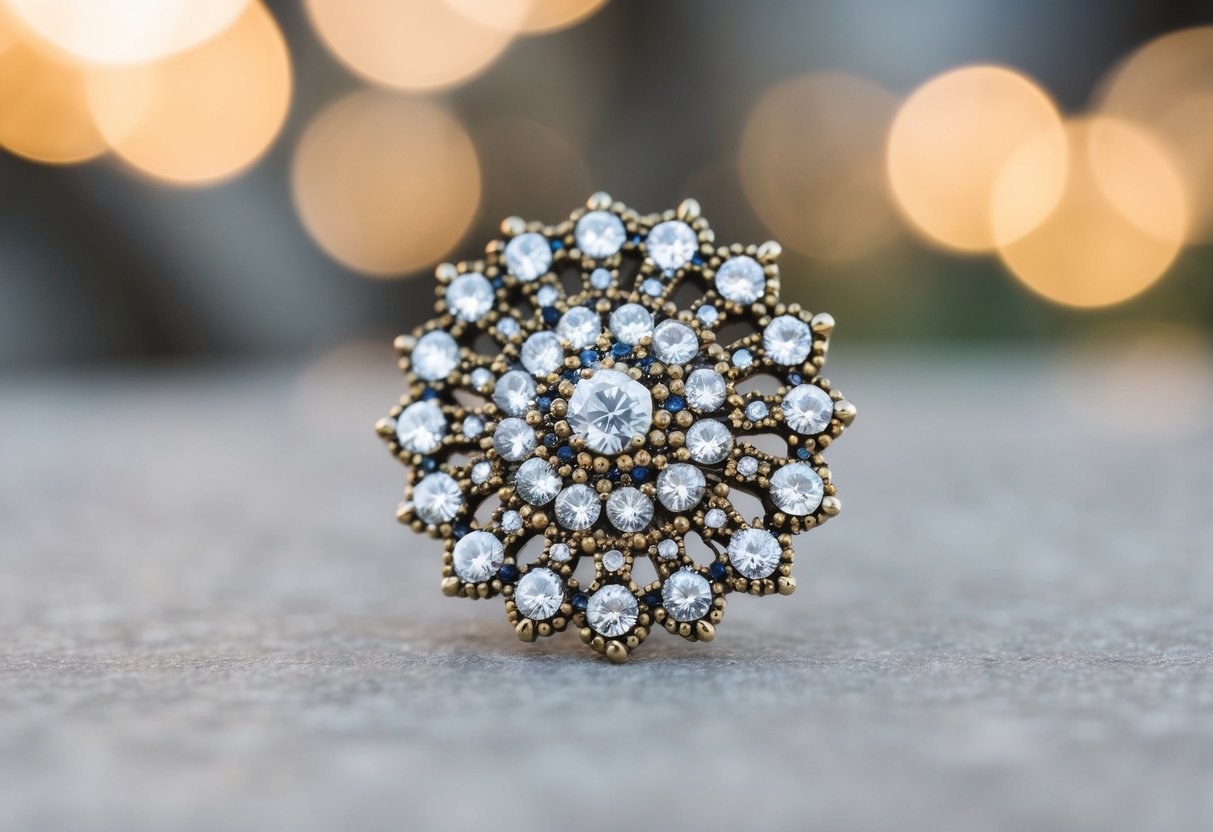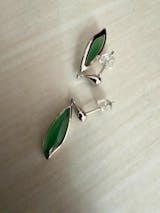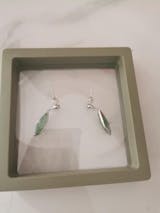
Brooch vs. Pin: Understanding the Differences and When to Wear Each
Check out our personalized jewelry collections! (kids drawing jewelry, coin jewelry, wire jewelry, fingerprint jewelry, handwriting jewelry, and more)
The debate between brooches and pins is more than just semantics; it's about finding the right accessory to complete our look. Brooches, often seen as more elaborate, are usually larger and feature detailed designs. Pins, on the other hand, tend to be simpler and smaller, offering subtle elegance.
Brooches have a rich history and bring a touch of vintage style to our outfits. They are perfect for formal events or when we want to make a statement. Pins are versatile and can be worn with both casual and formal attire. Their simplicity is ideal for everyday wear and adds a touch of charm without being overpowering.
As we explore the world of jewelry, knowing when to choose a brooch over a pin can enhance our style. By considering the design and purpose of each piece, we can make informed decisions that complement our outfits beautifully.
Key Takeaways
- Brooches are larger and often more ornate than pins.
- Pins are simpler and versatile, suitable for everyday wear.
- Choose based on design and the style of the occasion.
Defining the Essentials
When it comes to fashion, brooches and pins have their own distinct roles and charms. Knowing their differences can help us accessorize elegantly and make stylish choices with confidence.
What Is a Brooch?
A brooch is often an ornate piece of jewelry. It usually features intricate designs and is worn on clothing for decoration. Brooches come in various shapes, such as circles, flowers, or animals. They can be made from different materials, including gold, silver, and gemstones.
Brooches often have a clasp on the back. This helps them fasten securely to clothing. They are typically larger than pins and serve as statement pieces, adding a touch of sophistication to an outfit. Wearing a brooch can highlight a neckline or add flair to a jacket.
Many of us enjoy brooches for special occasions or formal events. They let us express our personal style while remaining elegant. Brooches are versatile accessories, making them a classic choice for fashion enthusiasts.
What Is a Pin?
A pin is a simple yet versatile accessory. Generally smaller than a brooch, it usually has a straightforward design. Pins are often used for practical purposes and can hold clothing together. They come in various forms, from lapel pins to tie pins.
One of the most common types is the safety pin. These are practical tools but can also be decorative. Pins are available in a wide range of styles and materials, allowing us to express our personalities subtly.
Many of us wear pins for casual occasions or daily wear. They offer a simple way to enhance an outfit without being too flashy. Whether for fashion or utility, pins remain an essential part of our accessory collection.
Historical Significance
Brooches and pins are more than just fashion accessories. They tell stories from different periods and cultures. Our fascination with these pieces reveals a lot about how jewelry trends have changed over time.
Brooches Through the Ages
Brooches have been around for thousands of years. Ancient people used them as both decorative and functional items. The Romans and Greeks wore brooches made from precious metals to hold their cloaks. Fast forward to the Middle Ages, and brooches became symbols of rank and wealth. Royals and nobles often wore elaborate brooches encrusted with gemstones.
During the Victorian era, brooches took on romantic meanings. Designs often included flowers, hearts, or mini portraits. As we moved into the 20th century, brooches became more varied. They reflected different art movements like Art Deco, with bold and geometric patterns. Today, they are seen as both vintage and modern statement pieces, cherished for their history and style.
Pins in Fashion History
Pins have their own unique journey. Initially, they served more practical purposes. In ancient times, pins were used to hold garments together. The Renaissance period saw pins becoming more decorative. They began to appear in more elaborate designs.
By the 19th century, pins evolved into hatpins, a popular fashion item for women. These pins were often long, adorned with gems or intricate metals, and served the dual purpose of securing hats and adding flair.
In the 20th century, lapel pins and badges became popular. These were often used for political or cause-related statement-making. Today, fashion pins are versatile accessories. They come in various designs, from simple shapes to intricate carvings, often reflecting personal style or cultural trends.
Design Elements
In comparing brooches and pins, we see differences in materials, craftsmanship, symbols, and motifs. These elements define their unique visual appeal and significance.
Materials and Craftsmanship
Brooches often feature luxurious materials like gold, silver, and precious stones. The level of detail in craftsmanship is impressive, with careful attention paid to every aspect. Artisans may use techniques like enameling or gemstone settings, which enhance the brooch's elegance.
Pins, in contrast, are often simpler. They might use materials like stainless steel or enamel. While they can be less expensive, they are no less charming. They often focus on practicality and everyday wear, making them great for casual outfits.
Craftsmanship is a highlight for both. Brooches and pins each reflect skill and design philosophies in their creation, giving each type its own appeal.
Symbols and Motifs
Symbols and motifs in brooches are often meaningful. They can represent family crests, cultural symbols, or floral patterns. Many are collectible, cherished for their historical significance and storytelling potential.
Pins tend to use trendy or whimsical symbols. Motifs can include pop culture references or cute animals, offering creative expression and personalization. They're frequently used to show off hobbies or affiliations, like clubs or sports teams.
Both brooches and pins use symbols to convey messages and emotions, making them more than mere accessories. They can tell stories and showcase personal style, turning each piece into a conversation starter.
Functional Differences
Brooches and pins, although similar, have distinct functional features. These differences can influence how and when we choose to wear them.
Closure Mechanisms
When looking at closure mechanisms, brooches usually feature a rotating latch or safety catch. This ensures they stay securely fastened to our clothing. They often use a hinged pin with a clasp.
Pins, on the other hand, have simpler mechanisms. Straight pins or tie tacks have a clutch or cap. These designs are less complex but provide adequate grip for lighter fabrics. Understanding the closure is essential. It affects how well the piece stays in place and suits our style needs.
Versatility and Usage
Brooches are known for their versatility. They can transform the look of a jacket or a scarf with ease. Their larger size and elaborate designs make them perfect for special occasions or statement outfits.
Pins lean towards daily use. Their smaller size makes them ideal for more subtle fashion touches. Tie pins can add flair to formal attire. Lapel pins show identity or interest, such as club memberships or hobbies. Depending on our fashion goals, we can choose between bold brooches or understated pins to match our outfit and mood.
Fashion and Style
Brooches and pins both add a touch of flair to outfits. Each has its own occasion and usage, bringing different styles and vibes.
When to Wear a Brooch
We often choose brooches for formal events. They add elegance to gowns and suits. A brooch can highlight the neckline or shoulders of a dress. It turns a plain outfit into something special. Brooches can also be worn on hats or scarves for that extra touch.
Brooches aren't just for formal wear. We can use them to dress up casual clothes too. Adding a brooch to a coat, sweater, or even a bag brings personality to everyday looks. Vintage brooches and modern designs offer lots of choices for any occasion.
When to Opt for a Pin
Pins work well for more informal settings. We might wear them on jackets, shirts, or backpacks. Pins show off our personality and interests. They are great for adding fun and color to everyday fashion.
Pins vary in size and design. They are often small and easy to mix and match with different clothes. We might group several pins together for a bold statement or keep it simple with just one. Their versatility makes them a favorite for casual outings and creative expressions.
Accessorizing Tips
When choosing brooches and pins, it’s helpful to consider how they work with other jewelry and where they should be placed. These factors can play a big role in turning any look into a cohesive ensemble.
Combining with Other Jewelry
When wearing brooches or pins, balance is key. We should aim to balance them with our earrings, necklaces, or bracelets. If our brooch or pin is bold or colorful, simple earrings and necklaces work best. This stops our look from feeling too busy.
For those who love matching sets, brooches with corresponding earrings can create a unified look. Remember that mixing metals is also fine. A silver brooch can sit well with gold jewelry if it’s done thoughtfully. Contrasting textures, like pairing a smooth silver pin with a rope necklace, can also add interest to outfits.
Stacking items on a single piece of clothing, like attaching multiple pins, can be a fun way to flaunt our unique style. Let’s not feel limited and experiment with different combinations until we find what feels right for us.
Placement and Proportions
Placement matters a lot for brooches and pins. We often see them on lapels, collars, or sweater necklines. Placing a pin to the side of a neckline can draw attention in a subtle yet stylish way. Larger brooches look good on coats or jackets, where they won't overwhelm smaller clothes.
Proportions are also crucial because a large pin on a thin fabric may not work well. Instead, we should choose a brooch that fits the material’s weight. Smaller, delicate pins suit lighter clothes like blouses or dresses. We can layer smaller pins together for an edgy vibe, or opt for a single statement piece for elegance.
In short, with the right placement and proportions, brooches and pins can enhance our style in many ways.
Care and Maintenance
Taking care of our brooches and pins ensures they stay beautiful and last longer. Keep them in a dry place, away from sunlight. Too much light might fade or damage delicate materials. It’s best to store them in a jewelry box or pouch to prevent scratches.
Cleaning is important, but we don’t need to do it too often. For metal brooches and pins, use a soft cloth to gently wipe them. If they have gemstones, be extra careful. A damp cloth with mild soap can be used, but make sure to dry them well. Never soak them in water.
For pins with delicate fabrics or embroidery, avoid getting them wet. A gentle brushing with a soft, dry brush can help keep them dust-free and looking fresh.
Checking for any loose parts or pins helps us address issues before they cause damage. Tighten any loose clasps or pins carefully. If we're unsure or need repairs, a professional jeweler can help.
Regular care keeps our brooches and pins looking their best, ready to complement our outfits for any occasion.
Trends and Popularity
Brooches and pins have seen a comeback in the fashion world. We notice more designers featuring them in their collections. Celebrities and influencers also wear these pieces, making them fashionable again.
For example, bold statement brooches are popular on the red carpet. They add a unique touch to simple outfits. Many people like how these brooches help express personal style.
Pins are popular among younger crowds. They enjoy quirky and fun designs that are playful. These pins often carry messages or feature favorite characters. Collecting them has become a hobby for many.
We also see a trend in mixing and matching brooches and pins. This creates personalized looks that feel fresh and creative. Layering these pieces can transform an outfit from calm to exciting.
Another interesting trend is the use of vintage brooches. These bring a nostalgic charm to modern outfits. Many hunt for unique, one-of-a-kind pieces that tell a story from the past.
Online platforms make it easy to find rare and custom pieces. This accessibility boosts the popularity of brooches and pins even more. People are excited to find styles that match their personality.
In our view, brooches and pins offer endless possibilities for creative expression. Whether it's a classic style or something more modern, these accessories continue to capture attention.
Selecting the Right Piece
When choosing between a brooch and a pin, consider the occasion. Brooches are often more ornate, making them perfect for formal events. Pins, on the other hand, can be casual or decorative.
Material matters too. If we're wearing something delicate, a lighter pin might be best. Heavier brooches are great for thicker fabrics like jackets or coats.
Think about design and color. A bold brooch can liven up a plain outfit. If we're going for a subtle touch, a small pin with a simple design works wonders.
Placement is key. Brooches usually go on the shoulder or chest area. Pins offer more flexibility, such as on hats or bags.
Here's a quick list to help us decide:
- Occasion: Formal (brooch), Casual (pin)
- Material: Heavy fabric (brooch), Light fabric (pin)
- Design Preference: Bold (brooch), Subtle (pin)
Frequently Asked Questions
We love diving into the details of jewelry pieces. Pins and brooches have unique features that set them apart in style and usage, from their types and pronunciations to where and how they are worn. Let's explore some common questions.
How can you tell apart a brooch from a lapel pin?
Brooches are often larger, decorative pieces. They can have gemstones, intricate designs, or unique shapes. Lapel pins are smaller, simpler, and usually worn on the lapel of a jacket. They often have a symbolic or decorative purpose.
What are the various types of brooches commonly used?
Brooches come in many shapes and styles. We can find cameo brooches, enameled brooches, and gemstone-studded brooches. Some are designed as flowers, animals, or abstract shapes. Vintage brooches often have a timeless appeal.
How do you properly pronounce 'brooch'?
The word "brooch" is pronounced like "broach." It rhymes with "approach." It's important to pronounce it correctly to avoid confusion with the similarly spelled word "broach."
What defines a brooch as suitable for men's fashion?
In men's fashion, brooches are often understated. They might feature sleek designs or neutral colors. Metallic finishes and geometric shapes are popular. These brooches can add a touch of personality to a suit or jacket without being overly flashy.
Can you explain the different types of clasps used in brooches?
Brooches typically use a few different clasps. The most common is a pin and catch clasp. Others include the trombone clasp and the safety clasp. These ensure the brooch stays securely fastened and doesn't fall off.
On which side is it customary for a woman to wear a brooch?
Traditionally, women wear brooches on the left side. Positioning can vary based on personal style and the outfit. Some choose to wear them at the neckline, on a hat, or even as a hair accessory.

